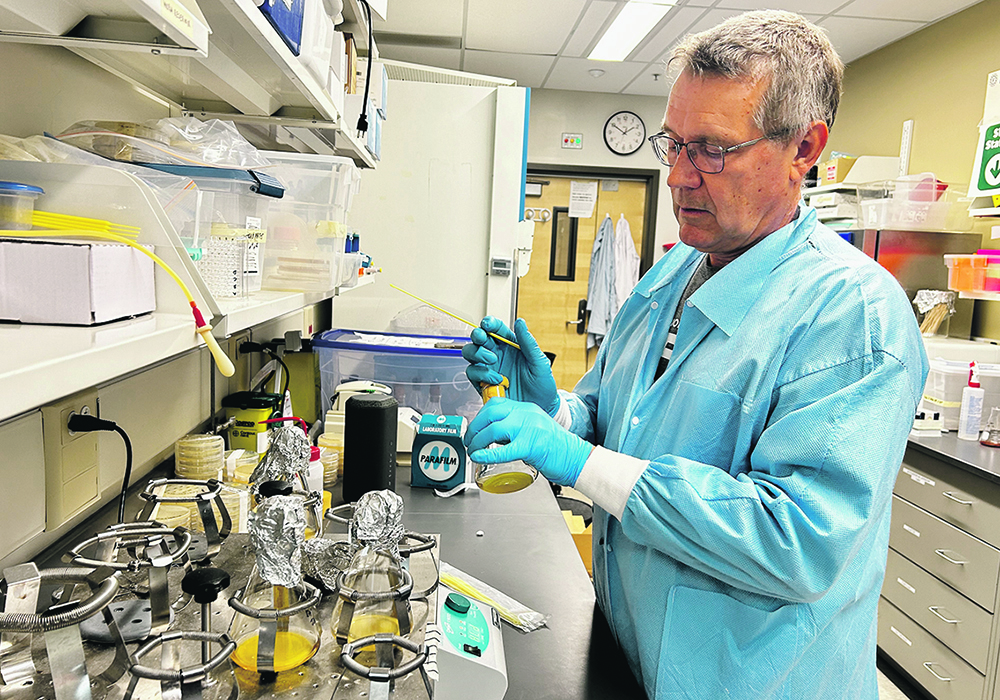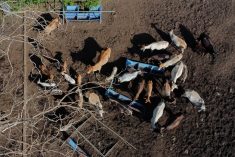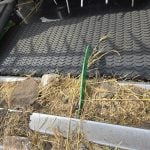WINNIPEG — Paul Holloway’s small lab at the University of Winnipeg isn’t cluttered, but it is busy.
On one counter there are microscopes, square plastic containers with blue lids and about eight flasks that contain a yellow-orange liquid.
On the opposite counter, petri dishes are stacked about 15 dishes high. Each dish is approximately 10 centimetres in diameter and two cm in height.
Inside those petri dishes are bacteria collected from soil in Mississippi — but not any ordinary bacteria.
Read Also

China’s grain imports have slumped big-time
China purchased just over 20 million tonnes of wheat, corn, barley and sorghum last year, that is well below the 60 million tonnes purchased in 2021-22.
These microbes are myxobacteria (pronounced mixxo), which are sometimes called “wolfpack” bacteria.
“They are predators. They are predators of (other) bacteria. But they also seem to go after fungi,” said Holloway, a microbiologist at the University of Winnipeg.
“They will pack together. Myxos actually swarm… It’s called a wolfpack.”
Sitting next to the counter beside the mysterious yellow-orange liquid in the flasks, Holloway explained that about one or two per cent of the bacteria in soil are myxobacteria.
They are unique in the world of soil micro-organisms because they seemingly work together and attack other microbes in a group.
“They come up to their prey and they circle their prey, then they kill (the bacteria) or fungi,” he said.
Holloway didn’t have a great deal of knowledge about myxobacteria until a few years ago, when one of his students wrote a paper on the carnivorous micro-organisms.
That paper sparked a light bulb moment.
Holloway wondered if myxobacteria could be used to kill pathogens that cause disease in Canadian crops such as canola.
The idea led to a research project, funded by the Canola Council of Canada, and Holloway is now studying myxobacteria to see if it can kill Leptosphaeria maculans, the fungus that causes blackleg in canola.
It is a major disease that infects the stem and in severe cases can dramatically decrease yield.
“Since myxobacteria are natural inhabitants of agricultural soil, it is possible to stimulate their populations in the soil to (control) Leptosphaeria maculans and other pathogenic fungi,” says a summary of Holloway’s research on the canola council website.
The description sounds simple, but Holloway’s research project is a long way from being ready for a commercial canola field.
He’s still at the proof of concept stage.
Holloway is trying to show that myxobacteria can kill the blackleg fungus in a petri dish.
The tests in the lab are straightforward.
“Somewhere in this mess … we have the blackleg fungi,” Holloway said, pointing to the stacks of petri dishes.
“Then we put (the) fungi on a plate and we put our myxobacteria here (on the edge of the fungus)…. Then you would see the myxobacteria swarm out and the fungi would just disappear.”
Again, that is the concept.
However, It hasn’t happened yet.
One major challenge has been finding myxobacteria in Manitoba soil. The myxos will form fruiting bodies in the soil, which look like little lumps — sometimes red or orange in colour.
However, finding those lumps and confirming they are myxobacteria is not easy.
“We wanted to go with local stuff … but it’s been quite difficult for us to isolate.”
To save time, Holloway contacted a scientist at the University of Mississippi who has found dozens of strains of certain species of myxobacteria.
Samples of those bacteria were recently shipped to Winnipeg so that Holloway could begin his project.
In the last couple of years, Holloway has learned that myxobacteria may be unique, but few agricultural scientists are studying their ability to kill fungi and bacteria in the soil, except for scientists in one country.
“Outside of China, there aren’t a lot of people working on myxobacteria,” he said.
“Most of the stuff (research) where you see myxobacteria versus pathogens for different crops comes out of China.”
Research activity may be minimal in agriculture, but medical scientists are curious about the wolfpack bacteria.
In the last few decades, scientists and companies have struggled to commercialize new types of antibiotics.
This means a family of bacteria that kill other bacteria could be a potential solution.
“There hasn’t been a new antibiotic in probably 10 years,” Holloway said.
“They talk about the golden age of antibiotics being the 1950s and ’60s. Just about everything you take (for antibiotics) … is going to be something developed in the ’50s.”
Some medical researchers believe myxobacteria could be harnessed to address all sorts of human health issues, including tools to fight cancer.
“Myxobacteria … are currently being explored as producers of new antibiotics. (They) are (being) functionally characterized to assess their ability to produce antibacterial, antifungal, anticancer, antimalarial, immunosuppressive, cytotoxic and antioxidative bioactive compounds,” a group of Indian scientists said in a paper published in Pharmaceutics.
If Holloway can prove that myxobacteria kill the blackleg fungus in the lab, the next step would be tests in a greenhouse.
If that works, then he would test the myxobacteria in a field setting.
Such research is years down the road, but the concept of using carnivorous bacteria to control crop pathogens is intriguing.
“Application of a commercial myxobacteria biocontrol product … in agricultural soil would be another tool in a blackleg control strategy,” the canola council says.
Convincing Health Canada and other regulators to approve a wolfpack bacteria product could be a major hurdle.
However, if myxobacteria do become commonplace in medicine, the road to commercial products in agriculture could become much smoother.
















